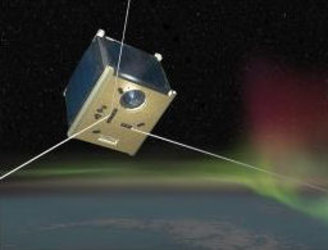Background on HumSAT
The HumSAT project is an international educational initiative for building a constellation of nano-satellites providing worldwide communication capabilities to areas without infrastructure.
HumSAT's first promoters are:
- University of Vigo (Spain)
- California Polytechnic University (USA)
- Autonomous National University of Mexico (Mexico)
- CRECTEALC - UN Regional Space Center (Mexico)
The HumSAT project will deploy a worldwide constellation of CubeSats with the associated ground segment and a user segment to provide telecommunications services in support to humanitarian and emergency applications, and to monitor parameters related to climate change. The system will provide data-relay services for sensors distributed around the world.
Two types of sensors will exist in the system:
- One-way sensors will transfer information to a remote user
- Bi-directional sensors will allow the transmission and reception of information off-line to/from a remote user
Some examples of sensors and data to be transferred could be simple telemedicine data, environmental information, or report on emergency situations.
The HumSAT system architecture is composed of three segments:
- A Space Segment, consisting of an orbiting constellation of small satellites based on the CubeSat standard - Secondary payloads could also be included in the HumSAT CubeSat
- A Ground Segment consisting of ground stations and CubeSat mission control centres based on the GENSO network
- A User Segment based on low cost equipment capable of transmitting one-way information to the user; or more sophisticated equipment capable of bi-directional communications
The HumSAT system will provide a standardised interface between the user equipment and the constellation. Information arriving to the ground control centre from sensors and equipment distributed worldwide is made finally available to the user through the internet. The system has already been presented in several international conferences and has gained the attention and support of a number of relevant international organizations in the space sector, as well as several countries.
Beyond the ESA involvement, the United Nations Office for Outer Space Affaires and the International Astronautical Federation are supporting the HumSAT project.















 Germany
Germany
 Austria
Austria
 Belgium
Belgium
 Denmark
Denmark
 Spain
Spain
 Estonia
Estonia
 Finland
Finland
 France
France
 Greece
Greece
 Hungary
Hungary
 Ireland
Ireland
 Italy
Italy
 Luxembourg
Luxembourg
 Norway
Norway
 The Netherlands
The Netherlands
 Poland
Poland
 Portugal
Portugal
 Czechia
Czechia
 Romania
Romania
 United Kingdom
United Kingdom
 Slovenia
Slovenia
 Sweden
Sweden
 Switzerland
Switzerland






























